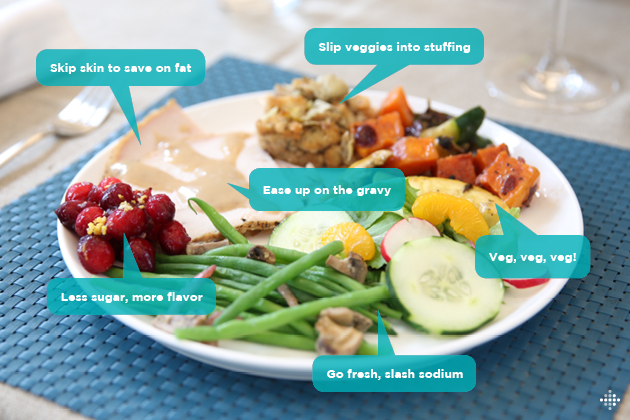
Thanksgiving is around the corner and with it marks the official onset of the party season, filled with celebrating, socializing, and good cheer. Unfortunately, excessive eating, drinking, and less time to exercise often comes along with all that merriment. But you don’t have to completely ignore your healthy eating goals during all the fun—it’s absolutely possible to fill up on the good stuff without feeling like you’re missing out. Take a look at these T-Day plates and see how easy it can be to celebrate without packing on the pounds.
A Traditional Plate vs. A Healthy Plate
While the standard Thanksgiving favorites are tasty, having a dollop or two (or three!) can quickly pack more calories, fat, and sodium onto your plate than you actually need.
| Traditional Plate | Healthy Plate |
| Total Calories 2400
Total Fat 90g
Total Carbohydrate 280g
Total Protein 110g Sodium 3500mg |
Total Calories 640
Total Fat 22g
Total Carbohydrate 76g
Total Protein 42g Sodium 700mg |
A Traditional Plate By the Numbers
All that dark-meat turkey with skin provides lots of fat and saturated fat. Stuffing soaked in gravy adds heaps of sodium, and still more saturated fat. More than half of this plate is covered with refined, or fast-releasing, carbohydrates—stuffing, corn bread, a dinner roll, mashed potatoes, no wonder you feel like unbuttoning your pants! Yes, potatoes are technically a vegetable, but when prepared for this meal they’re likely loaded with butter (saturated fat), cream (more fat), and salt. And the one veggie dish seen here isn’t exactly redeeming—green bean casserole is traditionally high in fat and sodium, too. Cranberry jelly is what it sounds like, jelly.
Take a look at the numbers and you’ll see why you really shouldn’t make room for one of these plates—let alone that second round you’ve already started thinking about getting up for.

On the Traditional Plate, you’ll find:
- 120% of the calories recommended for the entire day
- 1.3 times the total fat the average person needs in an entire day*
- More than twice the saturated fat the average person needs in an entire day
- Almost triple the total carbohydrate the average person needs in an entire day*
- Four times the total sugar recommended for the entire day
- Double the protein the average person needs in an entire day*
- 1.5 times the sodium limit for an entire day
*Based on Estimated Average Requirements for a 2000 kcal diet.
A Healthy Plate By the Numbers
Building a more balanced meal doesn’t mean you have to forgo your favorite holiday flavors. The idea is to lighten things up by doubling down on vitamin-packed veggies—fill half your plate with mixed greens and cooked vegetables, and you’ll still have room for a slice of pie later.
Switch to a couple of slices of skinless turkey breast and you’ll consume 10 times less fat. Go easy on the gravy—you want it to complement your serving of turkey, not drown it. Can’t have a holiday meal without stuffing? Instead of skipping it, make it healthier by using low sodium broth and replacing half of the bread in the recipe with sauteed vegetables, like mushrooms and artichokes—that, along with skipping the dinner roll and cornbread, can reduce your carbohydrate intake by two thirds! Adding a mixed citrus green salad brings a burst of refreshing flavor to an otherwise carb-heavy meal. And replacing the typical high-carb, high-sugar sweet potato casserole with grilled or roasted squashes, like butternut squash and zucchini, provides healthy vitamins and just as much holiday comfort. Fresh always beats canned, so opt for sautéed green beans with wild mushrooms to further slash fat and sodium, and try making your own cranberry sauce with antioxidant-rich cranberries.

Compared to the traditional plate, this healthy plate has:
- 1760 fewer calories
- 68 fewer grams of total fat
- 30 fewer grams of saturated fat
- 204 fewer grams of carbs
- 55 fewer grams of sugar
- 68 fewer grams of protein
- 2800 fewer milligrams of sodium
Tips for Your Thanksgiving Plate
Your actual plate will likely end up looking like something in-between these two, and that’s OK. At the end of the day, this is just one meal—one meal that you can easily bounce back from the day after. But if you go into the holiday with a healthy-eating game plan, staying on track with your goals will be a whole lot easier. A great strategy is to decide in advance where you’ll splurge and where you won’t. You don’t have to eat all the dishes offered simply because they are on the table. Opt for a portion of one decadent side, and skip all the other creamy, buttery, and cheesy stuff.
More good advice: Don’t arrive to the meal starving, go easy on the appetizers, and alternate each alcoholic beverage with a glass of water. Choose to be mindful and in control of your selections and portions, and you’re less likely to end the day feeling like that turkey—overstuffed and completely cooked.
Traditional or healthy—what’s your plan going into the big meal? Join the conversation!
This information is for educational purposes only and is not intended as a substitute for medical diagnosis or treatment. You should not use this information to diagnose or treat a health problem or condition. Always check with your doctor before changing your diet, altering your sleep habits, taking supplements, or starting a new fitness routine.

If you have questions about a Fitbit tracker, product availability, or the status of your order, contact our Support Team or search the Fitbit Community for answers.
Please note: Comments are moderated and may not appear immediately after submission.